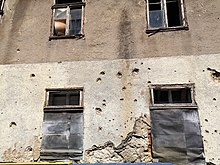Battle of Gospić
The remainder of 1991 saw further deterioration of the situation in the region, resulting in war crimes against Serbs and Croats in the Gospić and Široka Kula massacres.
Fighting in the region remained deadlocked, with little to no territorial gains to either side, until a lasting ceasefire was called with the signing of the Sarajevo Agreement of 2 January 1992.
[8] Control of the growing tensions became hampered by increasing support of SAO Krajina being provided by the Yugoslav People's Army (JNA).
[11] An already tense situation in the Lika region, following 1 April Plitvice Lakes incident when the first fatalities of the Croatian War of Independence occurred,[12] deteriorated further in June when Croatia reaffirmed its sovereignty through a parliamentary declaration.
Further escalation of the fighting was seen at the Ljubovo pass on the Gospić–Korenica road, where the JNA and SAO Krajina troops fought and pushed the ZNG back on 28–29 July.
[14] Ethnic violence continued to escalate when Serb paramilitaries abducted and killed five Croatian civilians from Lovinac in southern Lika on 5 August,[15] and a police checkpoint in Žuta Lokva was attacked.
[20] The garrison was supported by 128 Serbian Guard paramilitaries led by Đorđe Božović, which deployed to Gospić from Serbia using JNA transportation,[21] according to an interview with the commanding officer of the southern Lika Territorial Defence in 1991.
The 118th Infantry Brigade was commanded by Lieutenant Colonel Mirko Norac,[25] while the head of the Croatian police in Gospić was Ivan Dasović.
[18] The ZNG and Croatian police planned to cut power, water and communications to all JNA facilities in the government-controlled part of Croatia on 14 September.
[19] An infantry attack aiming to support the JNA garrison was successfully repelled by Croatian forces on 16 September in the Divoselo area,[27] where Božović was killed.
[18] After the city centre became relatively secure, the Croatian forces extended their offensive, capturing the Jasikovac Barracks and relieving two Croatian-held pockets in villages of Ribnik and Bilaj by 20 September.
By the end of September, Croatian defensive positions around Otočac were sufficiently reinforced that only minor attacks were launched and primarily near the village of Drenov Klanac.
[36] The killings in the Lički Osik area, known as the Široka Kula massacre, resulted in the deaths of 40 civilians, mostly Croats but also some Serbs suspected of supporting Croatia.
[38] In 1993, Croatian authorities charged Marcel Dusper, Tomo Čačić, Jovo Kuprešanin, Bogdan Odanović, Relja Tomić, Duško Bajić, Dane Drakula, Mićo Vasić, Goce Koneski, Slobodan Dotlić, Dragoljub Lazarević, Radovan Radenković, Bratislav Milojković, Stevo Milošević and Miloš Bogdanović, 15 former JNA officers, posted in Gospić garrison in 1991 with war crimes against a civilian population.

